Deciding to book a winter skills course is a matter of safety in the hills. You definitely don’t want to be the one who’s on the wrong end of a call to mountain rescue. Most rescue callouts stem from navigational error, but not being prepared for the wild conditions can be a contributing factor. The Cairngorms offer some of the most consistent full-on winter conditions for the aspiring winter walker. Learning here under the expert tutelage of experienced, qualified guides is an experience which will stand you in good stead for the rest of your life.
Andy Bateman of Scot Mountain Holidays gives you some of his experience as a result of 20 years of coaching winter skills and navigation in the Cairngorms.
As the first snows arrive on the mountains many hang up their hiking boots. They wait until spring to go out again. Yet if you continue to head out throughout the winter, you could have some sensational days out. Cold air holds less moisture so on a clear day the views go in forever, the horizon crystal clear. The wonderful Jack Frost creation that is rime ice marks the air flow aroundevery stone and boulder. This is all the result of freezing hill fog on the wind. Older lying snow is scoured by the wind to produce the wonderful flutings. These are called Sustrugi. All these natural sculptures interplay with the soft light of a winters day.
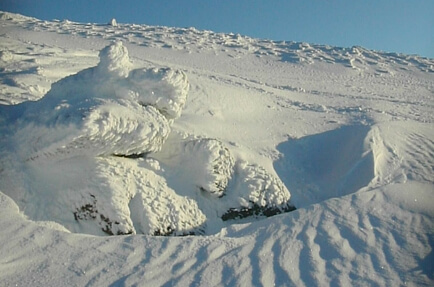
All kinds of natural sculptures appear in the hills during winter
Photo caption & credit: The snow turns the Cairngorm plateau into a place of beauty (taken by Andy Bateman, Scot Mountain Holidays)
Of course this environment isn’t without its hazards. It is no place for the ill prepared. Once trained in the essential winter skills there’s a very special sense of privilege. This comes from being able to exist confidently and comfortably in this hostile yet pristine and beautiful winter wonderland.
The conditions on the British mountains in winter are often as varied as the weather that’s created them. You need a good variety of skills at your disposal. Your winter boot is just as much a tool as your axe or crampons. It needs to be of adequate stiffness. On steep snow and ice covered ground good footwork is the watchword. Your approach should be from the perspective of prevention rather than cure. You should try step kicking and cutting or crampon techniques before resoring to the techniques of self-belay and self-arrest.
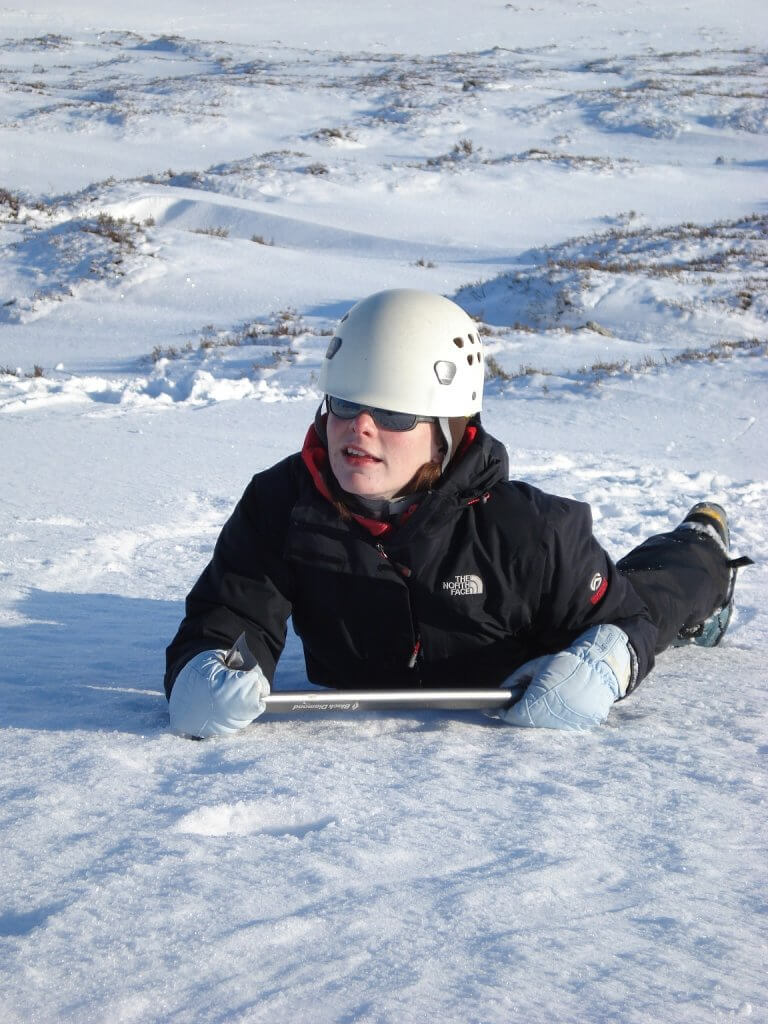
Self-arresting on a winter skills course in the Cairngorms
Photo caption: Practising winter skills in the Cairngorms – the classic feet first on your front self-arrest (5 day winter skills course with Scot Mountain Holidays)
Knowing though, that when all else fails, you can confidently and quickly stop a sliding fall, with or without an axe is a fantastic fillet to your confidence. Some of the self-arrest techniques are straight forward enough but others are not; sliding head first on your back is a case in point. Understanding the body position that is required for the forces of gravity to work in your favour is all important; in one fluent move you flip you’re yourself onto your front whilst swinging your legs beneath you – easy when the dynamics and body posture have been clearly explained.
For many the step up in navigation standard that’s demanded by the winter mountains is often the biggest challenge of all. Here the right approach is crucial and accuracy comes in a number of forms and levels. Being totally reliant on the absolute accuracy in your compass bearings and dead reckoning techniques (timing and pacing) has been the unravelling of many an aspiring Mountain Leader. In the often flat light conditions of winter, contour interpretation becomes even more imperative yet perceived poor visibility encourages folk to abandon this vital skill.
Many good mountain navigation techniques come in under the heading of “error management”. Some of these techniques will be familiar to the experienced: aiming off, collection features and attach points but these are just a few of the techniques that can be used to make life easier in the winter mountains. Good winter navigation skills could be the difference between stay on safe ground and straying onto that that is prone to a slide.
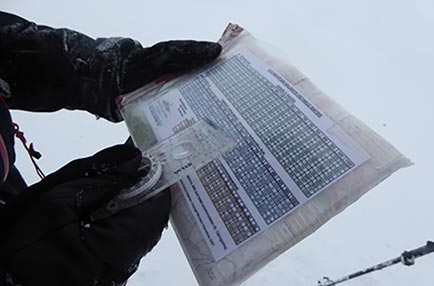
Highly skilled micro-navigation in practice
Photo Caption: Winter micro-navigation using Andy’s patented timing and pacing chart (winter navigation course with Scot Mountain Holidays)
Evaluating Avalanche hazard is another subject difficult to get a handle on. There are though pertinent points that, when borne in mind at the planning stage, can already be starting to reduce your chances of ever being caught in an avalanche. Yes, you could start avalanche hazard evaluation in the summer months long before the snow has arrived! It is of course though, an ongoing process of monitoring right through to the end of the trip and not least of which is viewing and understanding the avalanche forecast.
If you would like to discuss any of the points Andy raises in his article, please don’t hesitate to call him on 01479 831 331
Remember that Andy’s experience has been gained over 17 years of living and working in the Cairngorms. He aims to give you as much knowledge as he can while you’re here but it’s only in practicing the skills he introduces that you’ll gain proficiency yourself.
Which winter boots to choose for winter skills and winter hiking?
How to choose a walking ice axe for a winter skills course?
Why go walking in winter in Scotland?
How do I prepare for a winter skills course?

Andy, your fearless leader
Andy Bateman has instructed and guided for over 20 winter seasons in Scotland’s uncompromising mountains in the Cairngorms and beyond. Conditions can vary from blue skies and winter wonderland to raging blizzard, hurricane force winds and visibility of mere meters. Here are a few of his expert winter skills tips:
Unless your rucksack has a facility specifically for carrying crampons safely on the outside, they should be in a crampon bag inside your rucksack when not on your boots. They are heavy items of kit and can easily work loose when attached with exterior straps or bungee. Crampons carried on the outside can also be a source of injury for other members of the party.
At the begging of each winter season, check the condition of the soles of your boots. If they are worn it may be time to get them resoled or replaced. Having sharp(ish) edges to your soles means they will be effective at gripping and kicking into hard icy snow.
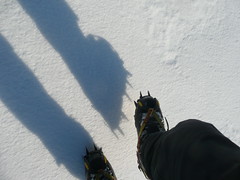
Crampons at work
The snow and ice conditions can be as varied as the weather that creates them. Don’t limit the techniques at your disposal before you’ve even set foot on the mountain. Your boot is as much a tool as your ice-axe or crampons. B1 boots are often too flexible to effectively kick steps in hard snow; if you try to front point the toes they tend to bend up and drop the heel, causing the wearer to fall backwards. Wear B2, or fully rigid B3, boots.
There are a few situations where a long shaft is an advantage but they are outweighed by the number of situations where a short shafted axe is your best bet. Go for an axe with a relatively straight shaft and no longer than 55cm.
Remember in winter trekking your rucksack will be heavier, plus the extra weight of winter boots and crampons on your feet, the underfoot conditions and having to check the map more frequently all conspire to slow your pace. On top of this there are fewer daylight hours. It’s important that you’re not over ambitious with your route plan to prevent being caught out.
Your rucksack is already heavier with all the necessary gear required by winter. Heavy boots, crampons and underfoot conditions will sap energy and slow you down. Don’t burdern yourself further with superfluous kit by considering whether an item is necessary for the day. At the same time, be sure you have everything you need.
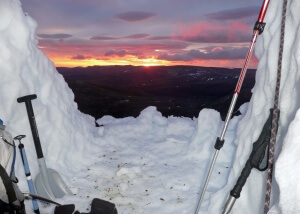 Full moon Snow-hole Expedition winter gear
Full moon Snow-hole Expedition winter gearEven with an insulated jacket around the tube, once the temperature drops below -3 deg C hydration bladders tend to easily freeze. You are better off with a water bottle on your sack.
There are situations where an ice axe leash is an advantage but there are also a good number of situations where they can be a hazard. Have an arrangement where the leash can be easily add or removed from the head of the axe, i.e. tie a loop in the end of the leash and larks-foot it through the head of the axe.
Remember, as your core temperature cools your body reduces your circulation to your extremities, like your hands. So if you have cold hands it may well be worth considering putting an extra layer on, as well as warmer gloves.
Your body can burn up 40% more calories just by keeping itself warm. Winter conditions and heavy gear add to your bodies energy demands. Standing around for more than 10 minutes can mean folks start to get chilled. Schedule in regular breaks where possible. I find a 10 min break after every 80 min of walking is optimal.
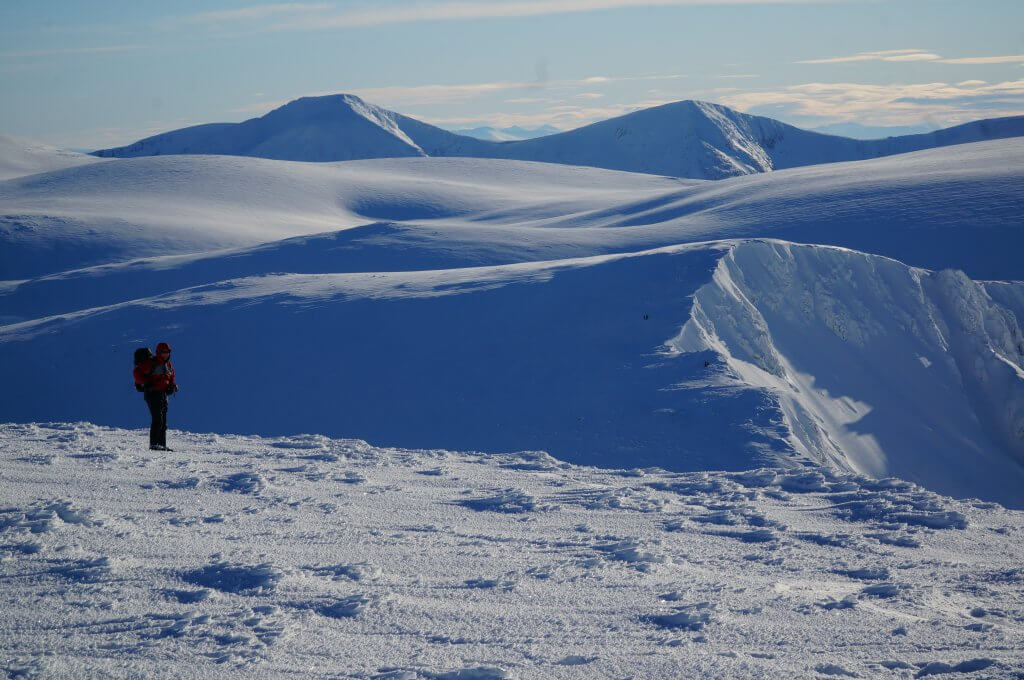
Striding out to conquer the winter Cairngorms
Why do it? Because this is why it’s worth it.
Andy Bateman of Scot Mountain Holidays leads at least 3 commercial snow hole expeditions in the Cairngorms Mountains every winter season. He has introduced scores of people to the magic of the winter season. He is also an expert at the skill of building a snow hole for a drip free night out in the mountains. To see what snowholing expedition experience is like for the customer check out our video on YouTube:
Seasonal temperatures on the high hills in Scotland are never as low as those in the valleys. You need to take this into consideration when planning to snowhole. Here in Boat of Garten we get temperatures of around -20oC. The lowest ever recorded temperature on the summit of Cairngorm is -16.5oC. Cold temperatures in the valley always occur under cold settled conditions. This is when the cold air drains off the mountain. The cold air then pools in the bottom of the valley. This means that in the Cairngorms the temperatures are never as low as in Norway.
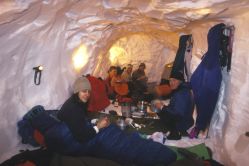
Enjoying an evening meal in the luxury palace makes the snowholing expedition unforgettable!
In Norway, you need to capture the warm air. Most people learn to build snow caves in Norway. They learn to create features which capture the warm air inside the shelter. In Scotland, however, you are operating much close to the melting temperature of snow so sloping entrances, sleeping platforms and cold air drains become much less important for the snow hole expedition.
Roof sag is a combination of the temperature rising too much, poor ventilation and not having a thick enough roof or having a large area of unsupported roof. A roof and front wall of approx. 1m thick is vital. If daylight can be seen through either the roof or the wall, they are probably too thin. However, bear in mind that a roof that thick will need an adequately thick & strong front wall.
Avoid large areas of unsupported roof by keeping your snow hole more like a tunnel, narrow. Aim for a distance of no more than 2 body widths, side by side lengthwise. This means you can create a steep-angled apex ceiling which helps to avoid any drip points and allows you to channel warm air towards ventilation holes.
Many snowhole sites by virtue of their high snow accumulation and steep slopes are prone to avalanches. To be safe, you may need to pick a slope with a more gentle gradient and spend more time digging into the slope. To maintain a 1m thick roof on a 30 degree slope you will have to dig horizontally 2m from the top of the doorway before widening out.
Make sure there is good ventilation and regularly watch your breath then you will avoid carbon monoxide poisoning. If you see it drifting off to one side, it’s a good indication that ventilation is adequate. Never cook in a snowhole without regularly checking there is adequate ventilation.
It’s a good idea to create ventilation holes in your snow hole because of the Scottish climatic conditions.
Make your snow hole large enough to stand up in so you don’t get back ache from crouching.
One potential hazard of digging a small snow hole is that you don’t have enough space to put the snow when you attempt to extricate yourself in the morning. One of the snowholes Andy built in the Cairngorms involved digging out through 1.5m of fresh, drifted snow to get out in the morning.
Never underestimate how hard the Scottish snow pack could be. At least make sure your snow shovel has a metal scoop and that you are also carrying a snow saw.
Time taken to construct your snow hole is vital. A communal snow hole can take 4 – 5 hours to dig to make sure that you have the best construction possible.
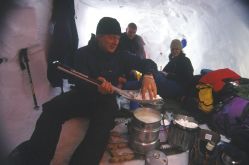
See more about our snow hole expedition!
All content © Copyright Scot Mountain Holidays 2024
Responsive web design by Summit Web Solutions